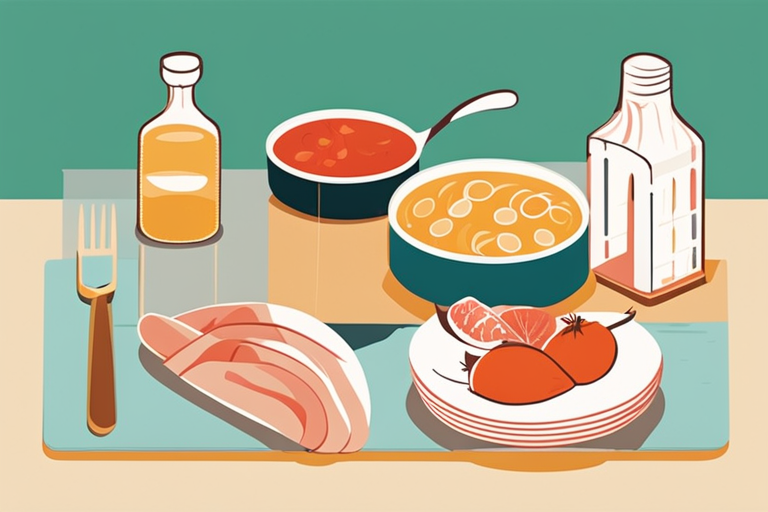
Share The Meals: A Guide to Safe Food Sharing
Get Your Free Food Safety Cheat Sheet
30 most common foods with instant answers. Print it and stick it on your fridge—completely free!
Share The Meals: A Guide to Safe Food Sharing
In today's fast-paced world, sharing meals has become a common practice among friends, family, and even neighbors. Whether it's a potluck dinner, a meal prep swap, or simply sharing leftovers, sharing meals can be a great way to bond and build community. However, when it comes to food safety, there are important guidelines to follow to ensure that the shared meals are not only delicious but also safe to eat. In this blog post, we will discuss the best practices for sharing meals and how to keep food safe during the process.
Why Share Meals?
Sharing meals is more than just a way to save time and effort in the kitchen. It promotes social interaction and strengthens relationships. Here are some reasons why sharing meals is beneficial:
- Community Building: Sharing meals brings people together, fostering a sense of community and belonging.
- Variety: By sharing meals, you get to try new dishes and cuisines that you may not have experienced otherwise.
- Cost-Effective: Sharing meals can help save money by splitting the cost of ingredients and cooking in bulk.
- Time-Saving: Meal sharing can save time on meal preparation, especially for busy individuals or families.
Food Safety Tips for Sharing Meals
When it comes to sharing meals, food safety should always be a top priority. Follow these tips to ensure that the shared meals are safe to eat:
1. Proper Storage
- Refrigeration: Ensure that perishable foods are promptly refrigerated to prevent bacterial growth.
- Labeling: Clearly label all containers with the date the food was prepared to track freshness.
- Freezing: Some dishes can be frozen for later consumption, but make sure to use proper freezer-safe containers.
2. Transporting Food
- Temperature Control: Use insulated bags or coolers with ice packs to keep hot foods hot and cold foods cold during transportation.
- Secure Packaging: Pack food in leak-proof containers to prevent spills and cross-contamination.
- Avoid Cross-Contamination: Keep raw meats separate from ready-to-eat foods to prevent foodborne illnesses.
3. Reheating Guidelines
- Thawing: Thaw frozen dishes in the refrigerator or microwave, never on the countertop.
- Reheating: When reheating shared meals, ensure that they reach an internal temperature of 165°F (74°C) to kill any harmful bacteria.
- Stirring: Stir food while reheating to ensure even heating throughout.
4. Allergy and Dietary Restrictions
- Communicate: When sharing meals, always ask about any allergies or dietary restrictions to avoid potential health risks.
- Ingredient Lists: Provide a detailed list of ingredients used in the shared dish to help individuals with allergies or dietary restrictions.
5. Cleanliness and Hygiene
- Handwashing: Always wash hands before and after handling food to prevent the spread of germs.
- Sanitization: Clean all utensils, cutting boards, and surfaces thoroughly to avoid cross-contamination.
- Food Handling: Use separate utensils for serving to prevent contamination.
Conclusion
Sharing meals can be a rewarding experience, but it's essential to prioritize food safety to prevent foodborne illnesses. By following the tips outlined in this guide, you can ensure that the shared meals are not only delicious but also safe for everyone to enjoy. Remember, when in doubt, throw it out! Happy meal sharing!

Authoritative Food Safety References
These agencies and university labs inform every tip and health precaution we publish.
USDA FoodKeeper – Cold Storage Guidelines
Official refrigerator, freezer, and pantry timelines maintained by the U.S. Department of Agriculture.
Visit USDA FoodKeeperFDA Produce Safety Rule & Grower Guidance
Field-to-fridge handling practices that prevent contamination of fruits, vegetables, and leafy greens.
Visit FDA Produce SafetyCDC Foodborne Illness Prevention Hub
Surveillance-backed guidance on pathogens, symptoms, and steps to reduce foodborne illness risk.
Visit CDC Food SafetyUC Davis Postharvest Technology Center
University research detailing optimal storage atmospheres for produce after harvest.
Visit UC Davis PostharvestPenn State Extension – Home Food Preservation & Safety
Peer-reviewed extension bulletins on safe canning, chilling, and reheating practices.
Visit Penn State ExtensionHow can I safely share homemade food with others?
What are the best practices for sharing meals during potlucks or gatherings?
How can I ensure food safety when sharing meals with vulnerable populations, such as children or elderly individuals?
Is it safe to share leftovers with others?
How can I communicate food safety guidelines to recipients when sharing meals?
Get Your Free Food Safety Cheat Sheet
30 most common foods with instant answers. Print it and stick it on your fridge—completely free! Want more? Upgrade to the complete guide with 70+ foods.
Scan your food directly and get instant safety info using our AI-powered camera feature.